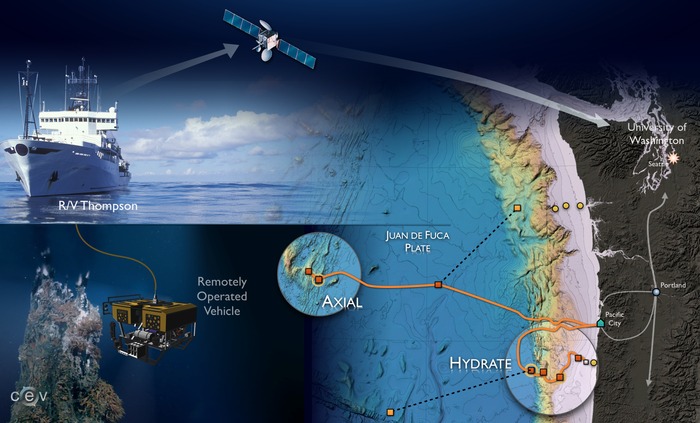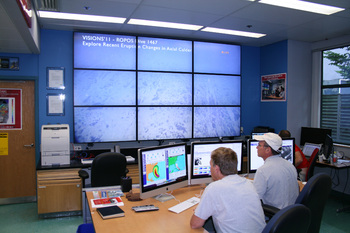For decades, researchers at the University of Washington have been studying the ocean and seafloor of the Northeast Pacific Ocean. Their fascination and enthusiasm for this region of hydrothermal activity, underwater volcanoes, methane seeps, methane ice deposits, and exotic life forms has continually inspired them to find ways to share their explorations and discoveries during research expeditions with audiences around the world. The overall goal of this outreach is nothing less than a transformation in how humans interact with and understand the oceans.
In 2005, the UW team produced three live one-hour broadcasts during the VISIONS 05 at-sea expedition. The shows included live HD footage from the Endeavour Segment of the Juan de Fuca Ridge, the first time this advanced technology had been used to broadcast live from the seafloor.
In 2010, an OOI expedition with scientists, engineers, and students went to sea to survey observatory cable routes and to map the main OOI cabled study sites. Their commitment to continue educating the public about the oceans led these oceanographers to piece together enough institutional non-OOI funding to conduct round-the clock webcasts with audio context. Key to "learning via telepresence" during expeditions is high-bandwidth satellite connectivity to conduct live, interactive broadcasts with shore-based audiences around the world.
For the VISIONS '11 OOI expedition in August 2011, with ship time funded by the National Science Foundation and the University of Washington, funds from private and institutional sources were invested in live high-resolution web broadcasts that incorporated social media. The state-of-the-art remotely operated vehicle ROPOS, a tethered underwater robot, was deployed from the UW Research Vessel Thomas G. Thompson. The 15 video and still cameras carried on ROPOS captured stunning high-definition imagery of the recently erupted Axial Seamount underwater volcano, one of the OOI cabled observatory's main study areas. As the imagery was streamed live via the Internet, viewers from around the world interacted directly with scientists and engineers on the ship.
For the piloting of the VISIONS At-Sea Telepresence (VAST) Program during VISIONS 11, four hour-long broadcasts were transmitted live to college classrooms at both the College of Charleston and Rutgers University. These broadcasts included live and archived HD video narrated by shipboard scientists, as well as documentaries created by UW students who were on the cruise. The broadcasts were supplemented by a comprehensive suite of web resources and a series of taped presentations and lectures. Also on VISIONS '11, live interactive sessions were held with scientists on the ship and visitors to Seattle's Pacific Science Center.
During the VISIONS '13 expedition in the summer of 2013, there were live interactive broadcasts with the informal science education venues of the Exploratorium in San Francisco and the Aquarium of the Pacific in Long Beach. Scientists on the ship also participated remotely in a Colorado meeting of the Internet2, K-20 Initiative. Student participants often took part in the twice-daily expedition updates and discussed their research.
Since 2014, this approach of "learning via telepresence" has made use of 24/7 real-time imagery from an HD camera connected at Axial Seamount in addition to live broadcasts and the VISIONS websites during the annual ship-based Operations and Maintenance expeditions.



